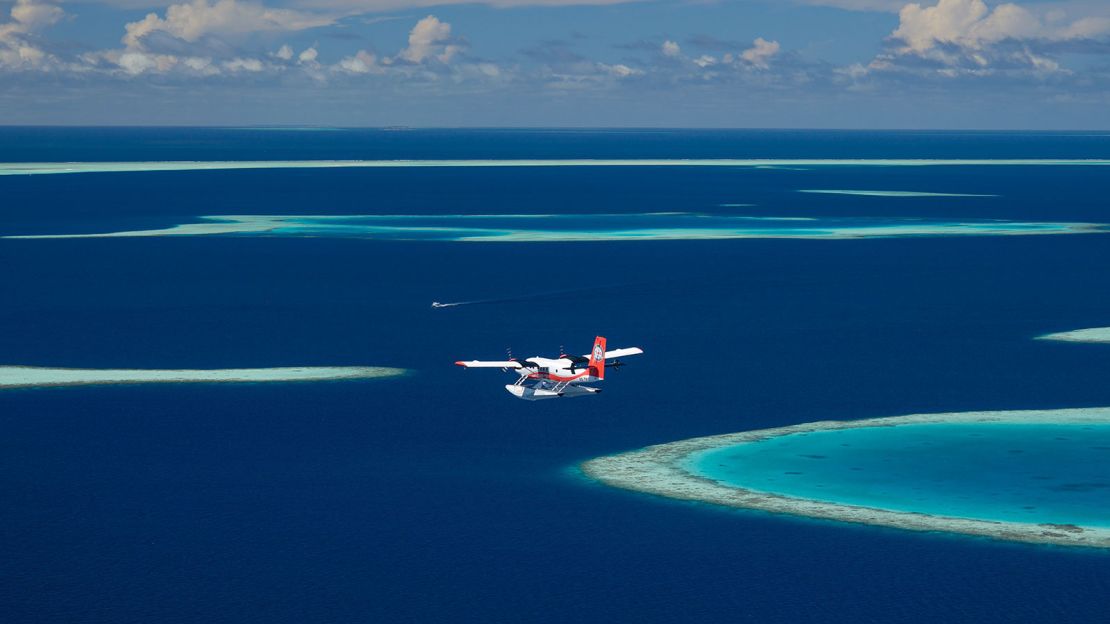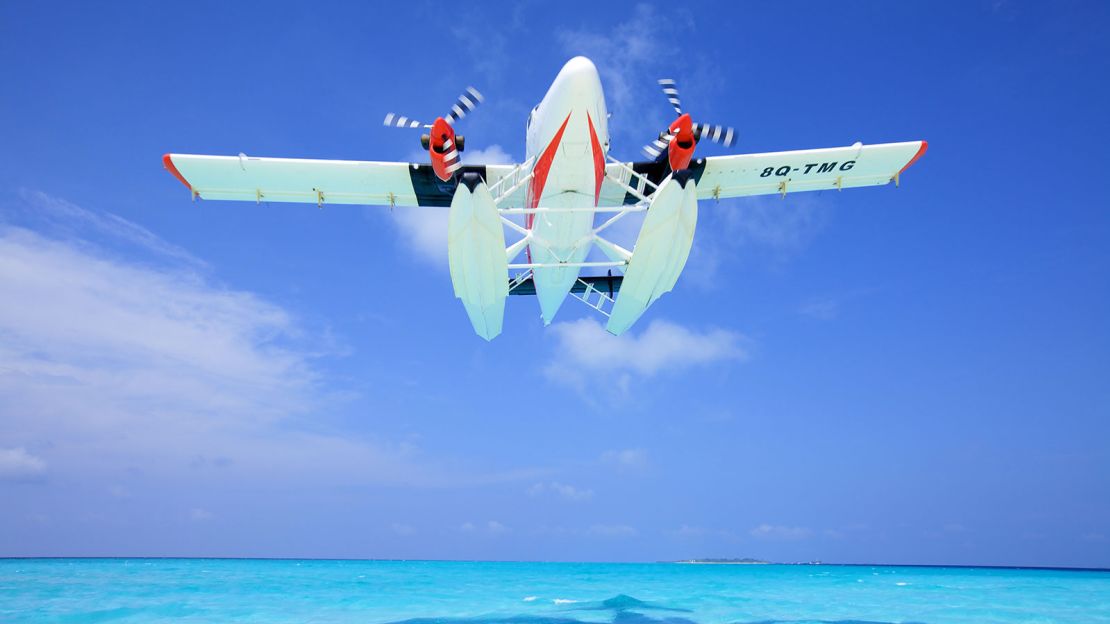If you’re heading to the Maldives for a holiday, there’s a strong chance your journey will include a flight on a seaplane.
This popular Indian Ocean destination is made up of 26 atolls filled with over 1,000 islands occupied by dozens of resorts, all spread out over 90,000 square kilometers.
As more resorts open in farther-flung areas, traveling to them by boat from Maldivian capital Male’s Velana International Airport is simply unfeasible for most.
That’s where Trans Maldivian Airways comes in.
Tthe world’s largest seaplane operator, it has a fleet of 50 aircraft flown by about 200 pilots and operates more than 100,000 flights per year, carrying passengers to dozens of Maldives resorts.

There are a couple of things that separate the pilots of Trans Maldivian from their global commercial counterparts.
For one, their runway is obviously the water.
Secondly, their attire. Though the pilots wear a conventional uniform from the waist up, this is accompanied by shorts and sandals.
Unless they’re in the skies, that is.
“We call ourselves ‘barefoot pilots’ because when we’re in the airplane we actually kick our sandals off and fly barefoot on the pedals,” says Captain Andrew Farr.
“It gives you a really nice feeling.”
It’s quite a sight, seeing these mavericks of the skies kick off their sandals, tan lines showing as they maneuver the air-con-free plane from its aquamarine base into the sky, engines growling loudly, the smell of fuel permeating the air.
Landing on water vs. land
Farr, who’s been with the airline for more than 10 years, is originally from Canada.
It’s fitting, given Trans Maldivian’s entire fleet consists of Twin Otters, which were made in Canada.
These twin-engine turbine-powered aircraft can be fitted with wheels, skis or floats and thus are ideal to operate in all conditions, whether it’s the Arctic subzero temperatures of the Canadian winter or the tropical climates of destinations like the Caribbean.
World's largest float plane operator: Trans Maldivian Airways
“It’s a lot more fun and challenging, I think, to land on water because the water is always changing,” says Farr.
“You can have a completely glassy day and everybody thinks that that’s the easiest way to land. But it isn’t, because it reflects the sky. You have to be very, very careful when you’re landing in glassy water conditions.
“During our southwest monsoon, we can get high winds and the waves can get four or five feet high sometimes with large swells. I really like the challenge of adapting to that and having different ways to land in different conditions.”
Logistical challenges
Unlike regular commercial airlines, Trans Maldivian’s schedule changes by the hour, depending on the needs of the resorts and whether passengers are arriving for their holiday or rushing to catch their international flight home.
Weather adds another dimension.
“There’s lots of times, for instance, when we have really bad weather – you may have to circle around before you get to the resort,” says Farr. “You might be landing five minutes late, so that changes the entire schedule.”
Operations are crammed into a relatively short time frame as the planes only fly during the day as per VFR – visual flight rules. To sum it up in one line, pilots need to see where they’re landing.
“We’re limited to sunrise to sunset and we do fly from sunrise to sunset most occasions,” says Farr.
Occasionally, this means pilots can squeeze in a night at a luxury resort if the last drop off of the day is too late. Another perk of the job.
But then there’s the downside. Farr’s alarm goes off at 4:00 a.m. every day and he’s at the Trans Maldivian headquarters by 5:20 a.m.
Following pre-flight preparations, he takes off at 6 a.m.
The rest of the day is spent flying the Maldives skies.
“On average, we would do probably five flights a day, with as many as 10 to 12 sectors – meaning we go to 10 or 12 different resorts over the course of the day,” he explains, adding this is equal to about five hours of flying per day.

Pre-flight preparations include working out the plane’s weight.
The Twin Otter has a maximum takeoff weight of 12,500 pounds, though not all of the planes weigh the same, says Farr.
“So you have to take what they call the ‘basic empty weight’ of the aircraft and then figure out what your useful load can be. And that has to include fuel, passengers and luggage.
“When we get here in the morning, you check the plane, you do a walk around the plane to make sure everything’s operating properly and there’s nothing broken or anything like that. And then you get a text on your phone which tells you where you’re going, how much fuel you need, how many passengers you have and the weight of your luggage. Then you have to work out a center of gravity and balance for the airplane.”
The airline has two derivatives of the Twin Otter. This is because the De Havilland DHC-6 Twin Otter was discontinued in the late eighties, but then a company in Canada – Viking – acquired the rights to manufacture it once again in the 2000s.
“But they completely upgraded the avionics,” says Farr.
“If you look in the cockpit, it looks like you’re in a 737 or a big jet. It’s an all-glass cockpit with computer screens, so everything else but the plane is basically the same as the old twin otters. But when you sit in the cockpit it doesn’t look anything like the old ones. We have to have special training to fly them. And most of us are flying it now.”
The life of a float plane pilot
Farr says his father was a pilot so he gravitated towards aviation from a very early age. By seven, he already knew that he wanted to fly float planes, having had a chance to ride in one for the first time on his birthday.
“I can still remember the feeling, seeing the water on the float, flying over the cottage and seeing my mother waving,” he recalls, smiling.
“I knew at that time that I wanted to do this for a career for life.”
As for what brought him to the Maldives, Farr says it was a combination of factors – including the lack of snow.
“As a float plane pilot in Canada, I was always aware of the operations here so it was always sort of my dream to get here somehow,” he says.
“Just before I came I was working in the very far north and one day in the winter it went down to -52 C (-61.6 F) and I said, ‘there has to be a better way. I love Canada, don’t get me wrong. If they could do something about winter, I might live there again.”
Farr isn’t the only expat. The airline has a lot of pilots from Canada, the United States and Europe, as well a few from the Caribbean, in addition to local Maldivian pilots. And he gets contacted all the time by pilots asking him how they sign up, he says.
First off, you need to be trained as a commercial pilot.
“The average co-pilot here would come with maybe 1,000 hours and then he or she would work for two or three years until they got the necessary experience to be able to move up to being captain,” says Farr.
The training is very, very thorough, he says, and includes courses on the aircraft systems, safety and emergencies.
“It’s just like flying for a regular airline but is a lot more fun,” he says.
A big part of that fun factor is dealing with passengers. Most fliers are going on holiday, meaning they’re usually in good spirits.
“I would say at least once a week, if not more, I’ll have somebody tell me I have the best job in the world. And I feel that I do,” he says.
“Everybody is always smiling and very excited. Sometimes people will tell me, “This is my first time on a seaplane,” and so I try extra hard to make it the best flight they could ever have.”
And then of course you’ve got the views.
“Every day from the airplane we’re flying over the same areas, but the scenery changes – the water, the colors, the sand, the light” says Farr.
“The view from my office is the best in the world.”











































